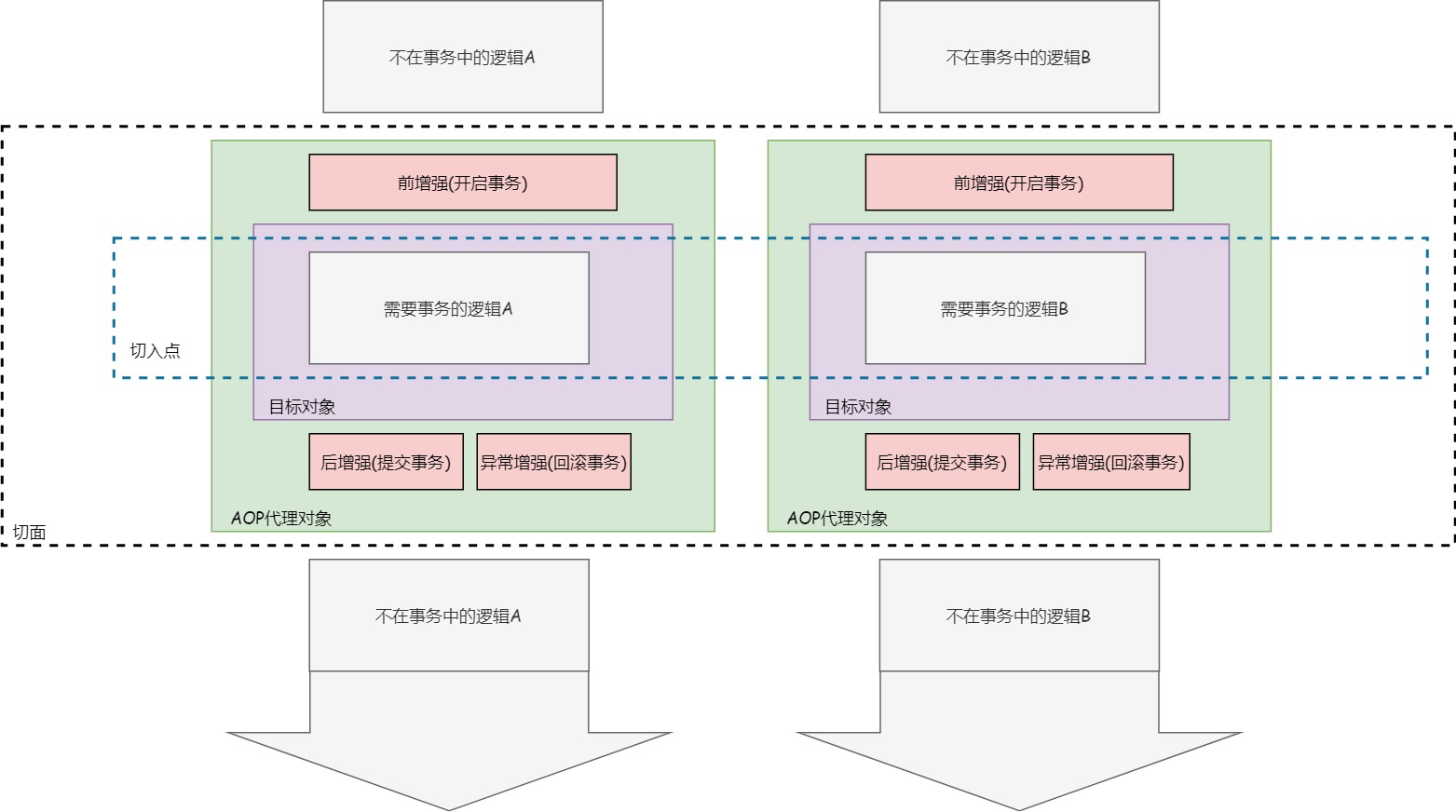Spring基礎只是—AOP的概念介紹
Spring容器包含兩個重要的特性:面向切面程式設計(AOP)和控制反轉(IOC)。面向切面程式設計是物件導向(OOP)的一種補充,在物件導向程式設計的過程中程式設計針對的目標是一個個物件,而面向切面程式設計中程式設計針對的目標是一個個切面。切面支援跨型別跨物件(如事務的切面可以加在任何地方)進行模組化。
前言
AOP是Spring的關鍵特性之一,雖然Spring的IOC特性並不依賴於AOP(意味著你可以只使用Spring的IOC特性而不使用AOP特性),但是二者結合起來可以靈活的實現很多中介軟體解決方案。比如我們經常使用的事務(@Transaction),就是通過AOP方案實現的。本文重點介紹AOP程式設計中的一些術語,這些術語不僅僅侷限於Spring,它適用於所有的AOP程式設計。

- 切面(Aspect):面向切面程式設計可以跨類跨物件進行切面程式設計,一個切面就是對一類橫切關注點的模組化。
- 切入點(JoinPoint):程式執行過程中的一個點,如方法呼叫、欄位存取和異常丟擲等。
- 增強(Advice):用於對切面增強,包含前增強、後增強和環繞增強。大多數AOP框架會對切入點進行攔截,並在切入點維護一個攔截器鏈。
- 目標物件(TargetObject):包含一個或者多個切面的物件。
- AOP代理(AOPProxy):通過Java動態代理或者CGLib增強得到的代理物件。
- 織入(Weaving):將切面整合到完整的流執行流程。
Spring的AOP的功能和目標
Spring的AOP使用純Java語言實現(如AspectJ就不是Java語言),不需要任何額外的編譯流程,不需要修改類載入器,適用於任何Servlet容器和應用服務。Spring的AOP只支援方法攔截,不支援欄位攔截,如果使用者需要使用欄位攔截,可以考慮引入AspectJ等類似的框架。
Spring的AOP框架和其它的框架有些不同,Spring的Aop框架不僅僅是為了提供一個AOP功能,它更重要的功能是和Spring的IOC容器結合,提供一些企業應用服務的解決方案(如事務等),我們可以和定義一個普通Bean一樣的方式去定以一個切面。Spring的AOP不支援非常細粒度的AOP,只支援對容器中的Bean進行AOP,如果需要更細粒度的AOP,可以考慮使用AspectJ。Spring容器的一個優秀的特性就是非侵入性,所以你可以靈活的選擇自己的AOP方案,不一定非要使用Spring的方案。
代理方式
Spring對實現介面的方法預設使用Java動態代理實現AOP攔截,對於非介面方法則會使用CGLIB位元組碼工具實現代理。
@AspectJ的支援
@AspectJ註解可以把一個普通的Java類宣告為切面。@AspectJ註解是AspectJ5引入的註解,Spring雖然可以讀取AspectJ5的註解用於切面後設資料的設定,但是在執行的時候使用的仍然是Spring AOP進行代理,而沒有使用AspectJ的編譯器或者織入邏輯。我們會在後續討論如何在Spring中使用AspectJ的編譯器和織入邏輯。
啟用@AspectJ
Spring預設沒有啟用AspectJ,如果你需要Spring支援@AspectJ註解對應的切面,可以通過在設定類上新增註解或者使用XML啟用設定(AspectJ所在的包是:aspectjweaver.jar)。
通過Java註解啟用AspectJ註解支援:
@Configuration
@EnableAspectJAutoProxy
public class AppConfig {
}
通過XML設定啟用AspectJ註解
<aop:aspectj-autoproxy/>
定義一個切面
當啟用AspectJ支援之後,開發者定義的任何Aspect切面會自動地被檢測到,然後Spring AOP會對切面進行攔截。下面兩個例子展示瞭如何設定AspectJ切面,你可以通過新增@Component註解把切面Bean註冊到Spring容器中。
<bean id="myAspect" class="org.xyz.NotVeryUsefulAspect">
<!-- configure properties of the aspect here -->
</bean>
package org.xyz;
import org.aspectj.lang.annotation.Aspect;
@Aspect
public class NotVeryUsefulAspect {
}
宣告一個切入點
切入點程式執行過程中我們感興趣的一個點,Spring的AOP框架只支援發現對Spring Bean方法上的切入點,因此你可以簡單的把切入點理解為SpringBean的方法。
切入點確定感興趣的連線點,從而使我們能夠控制何時執行通知。springaop只支援springbean的方法執行連線點,因此可以將切入點看作與springbean上方法的執行相匹配。切入點宣告由兩部分組成:一部分是由名稱和任何引陣列成的簽名,另一部分是確定我們感興趣的方法執行的切入點表示式。在AOP的@AspectJ註釋樣式中,切入點簽名由常規方法定義提供,切入點表示式由@pointcut註釋指示(用作切入點簽名的方法必須具有void返回型別)。切入點由兩部分組成,一部分是用於區別不同切入點的標識(下面例子中的private void anyOldTransfer() {})),另外一部分是確定我們感興趣的Bean方法的表示式(下面例子中的@Pointcut("execution(* transfer(..))")), 下面的例子展示了一個切入點的定義:
@Pointcut("execution(* transfer(..))") // the pointcut expression
private void anyOldTransfer() {} // the pointcut signature
Spring匹配切入點的語法使用了AspectJ5中的表示式語法,我們可以參考AspectJ檔案相關的語法.
常見的切入點匹配表達
Spring支援下面常見的AspectJ切面定義語法:
- execution:用於匹配方法的連線點。
@Pointcut("execution(public * *(..))")
private void anyPublicOperation() {}
- within:用於匹配型別內的方法。
@Pointcut("within(com.xyz.myapp.trading..*)")
private void inTrading() {}
- this:匹配當前AOP代理物件的執行方法
@target(org.springframework.transaction.annotation.Transactional)
- target:target匹配目標物件的型別,即被代理物件的型別,例如A繼承了B介面,則使用target("B"),target("A")均可以匹配到A
// 當前AOP物件實現了 IPointcutService介面的任何方法
@Pointcut("target(cn.javass.spring.chapter6.service.IPointcutService)")
private void anyPublicOperation() {}
- args:用於限定切點方法的引數型別。
args(java.io.Serializable)
- @target:被代理物件應該包含指定的註解。
@target(org.springframework.transaction.annotation.Transactional)
- @args: 被代理物件的引數包含指定的註解。
@args(com.xyz.security.Classified)
- @within: 被代理的物件應包含指定註解
@within(org.springframework.transaction.annotation.Transactional)
- @annotation:切入點包含指定的註解。
@annotation(org.springframework.transaction.annotation.Transactional)
我們可以通過「&&」和「||」對多個條件進行組合,AspectJ還有很多其它的表示式,但是Spring不支援除上述表示式以外的其它表示式。AspectJ其它表示式包含: call, get, set, preinitialization, staticinitialization, initialization, handler, adviceexecution, withincode, cflow, cflowbelow, if, @this, @withincode等。
我們在使用Spring的代理方法之前,應該知道其代理原理。Java動態代理只能攔截public介面方法上的呼叫,CGLib只能攔截public、protected和defult方法。如果你需要更深層次的攔截,可以考慮使用底層的Aspectj。
切面的增強
我們在上面的步驟定義好了一個切入點,我們現在就可以對這個切入點進行額外操作,這些額外操作被稱為增強,Spring支援四種增強方式:前增強、後增強、異常增強和環繞增強。Spring支援在增強方法的定義上直接定義切入點。
前增強BeforeAdvice
import org.aspectj.lang.annotation.Aspect;
import org.aspectj.lang.annotation.Before;
@Aspect
public class BeforeExample {
@Before("com.xyz.myapp.CommonPointcuts.dataAccessOperation()")
public void doAccessCheck() {
// ...
}
}
import org.aspectj.lang.annotation.Aspect;
import org.aspectj.lang.annotation.Before;
@Aspect
public class BeforeExample {
@Before("execution(* com.xyz.myapp.dao.*.*(..))")
public void doAccessCheck() {
// ...
}
}
後增強
import org.aspectj.lang.annotation.Aspect;
import org.aspectj.lang.annotation.AfterReturning;
@Aspect
public class AfterReturningExample {
@AfterReturning(
pointcut="com.xyz.myapp.CommonPointcuts.dataAccessOperation()",
returning="retVal")
public void doAccessCheck(Object retVal) {
// ...
}
}
異常增強
import org.aspectj.lang.annotation.Aspect;
import org.aspectj.lang.annotation.AfterThrowing;
@Aspect
public class AfterThrowingExample {
@AfterThrowing(
pointcut="com.xyz.myapp.CommonPointcuts.dataAccessOperation()",
throwing="ex")
public void doRecoveryActions(DataAccessException ex) {
// ...
}
}
環繞增強
import org.aspectj.lang.annotation.Aspect;
import org.aspectj.lang.annotation.Around;
import org.aspectj.lang.ProceedingJoinPoint;
@Aspect
public class AroundExample {
@Around("com.xyz.myapp.CommonPointcuts.businessService()")
public Object doBasicProfiling(ProceedingJoinPoint pjp) throws Throwable {
// start stopwatch
Object retVal = pjp.proceed();
// stop stopwatch
return retVal;
}
}
代理機制
我們前面說過,Spring AOP通過動態代理和CGLIB實現AOP物件的代理。我們可以通過如下設定設定動態代理全部走CGLIB。
<aop:config proxy-target-class="true">
<!-- other beans defined here... -->
</aop:config>
代理工廠的使用
Spring AOP實現代理的核心類是AspectJProxyFactory,我們可以使用這個類程式設計式生成代理物件:
// create a factory that can generate a proxy for the given target object
AspectJProxyFactory factory = new AspectJProxyFactory(targetObject);
// add an aspect, the class must be an @AspectJ aspect
// you can call this as many times as you need with different aspects
factory.addAspect(SecurityManager.class);
// you can also add existing aspect instances, the type of the object supplied must be an @AspectJ aspect
factory.addAspect(usageTracker);
// now get the proxy object...
MyInterfaceType proxy = factory.getProxy()
本文最先發布至微信公眾號,版權所有,禁止轉載!